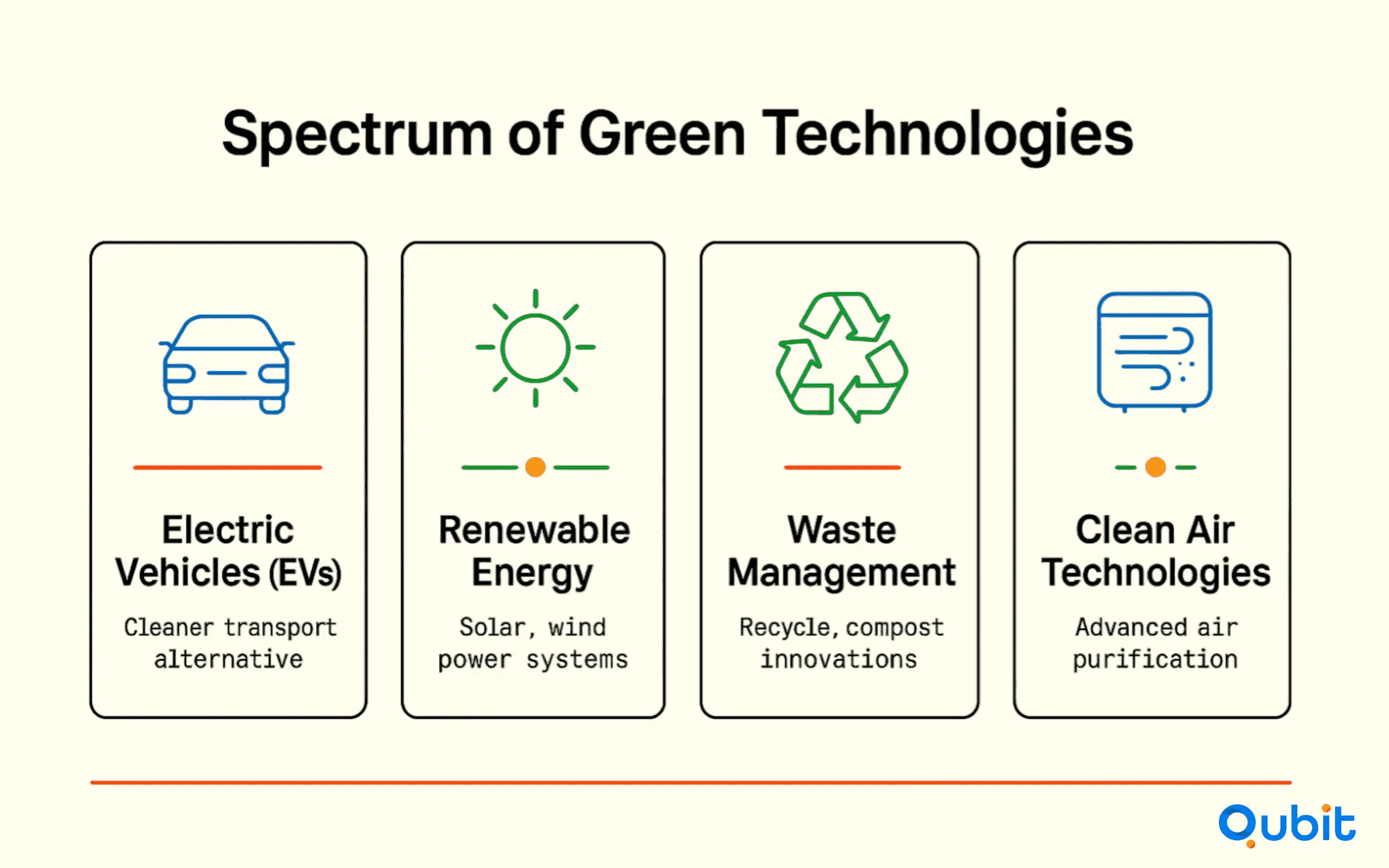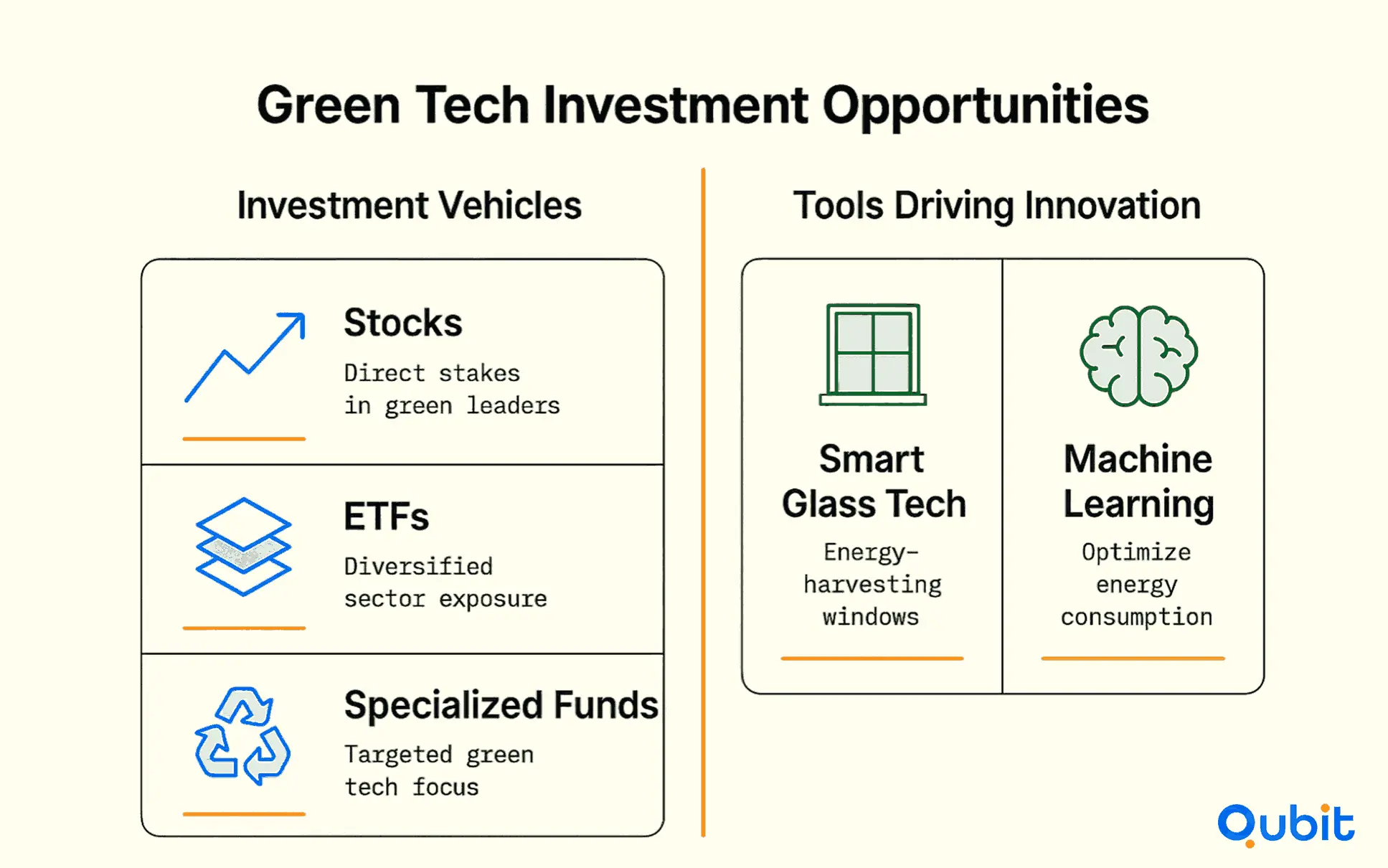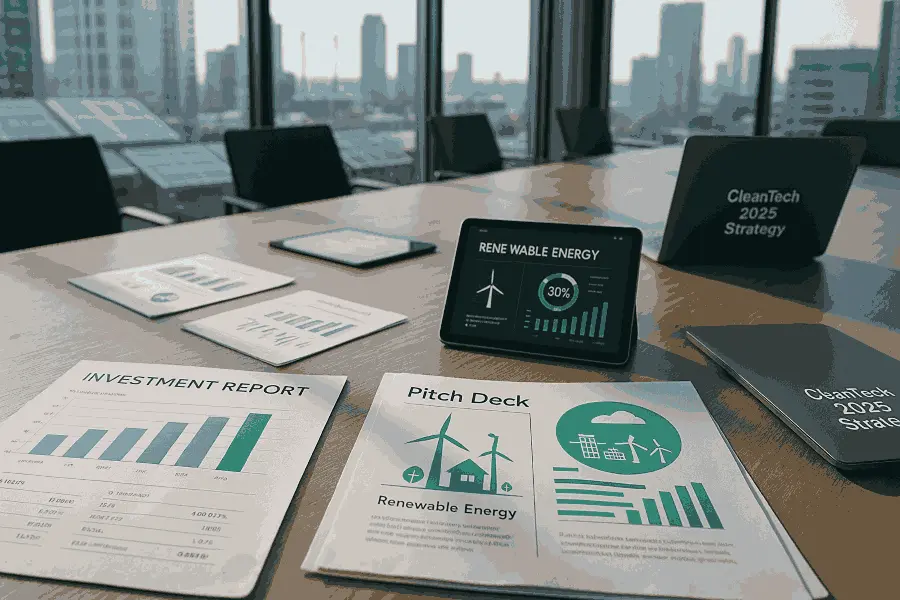Green technology is reshaping industries, offering innovative solutions to combat climate change while driving economic growth. For cleantech start-ups, scaling operations often hinges on securing investments that align with their environmental mission. Investors are increasingly drawn to this sector, recognizing its potential for both financial returns and global impact.
Understanding the nuances of cleantech startup fundraising strategies can provide a solid foundation for navigating this dynamic space. The super-pillar presents a comprehensive overview of funding dynamics, where the discussion on cleantech startup fundraising strategies clarifies foundational aspects of securing investment for environmental ventures.
With global green tech investments projected to surpass $2.1 trillion by 2024, the time to act is now. Let’s jump right in!
Why Green Tech Investment Matters Now
The urgency to invest in green technology has never been more apparent. According to the United Nations Environment Programme's Emissions Gap Report 2024, global emissions rose by 1.3% from 2022 to 2023, underscoring the inadequacy of current mitigation efforts and the pressing need for innovative solutions. This rise in emissions highlights the critical role green tech must play in addressing climate challenges.
In 2024, global green tech investment reached a record-breaking $2.1 trillion, demonstrating unprecedented momentum in sectors like electrified transport, renewable energy, and modernized power grids. These figures reflect not only the growing interest but also the tangible commitment to reshaping the global energy landscape. Electrified transport and renewable energy have emerged as dominant forces, driving funding flows and accelerating the transition to a sustainable future.
It’s essential to distinguish green tech investing from traditional ESG (Environmental, Social, and Governance) investing. While ESG focuses broadly on corporate responsibility, green tech zeroes in on transformative technologies that directly combat climate change. This targeted approach is pivotal for scaling renewable energy solutions and electrifying transportation systems, both of which are crucial for reducing emissions and achieving global sustainability goals.
The record investment in green technology is more than a financial milestone—it’s a signal of the world’s readiness to embrace innovation for a cleaner, greener future. As emissions continue to rise, the need for bold investments in green tech becomes increasingly urgent.
Exploring the Spectrum of Green Technologies
Green technology encompasses innovative solutions designed to minimize environmental impact while promoting sustainable practices. From electric vehicles to renewable energy systems, these advancements are reshaping industries and addressing critical ecological challenges.

Electric vehicles (EVs) are a prime example of green technology, offering a cleaner alternative to traditional combustion engines. However, as detailed in the Environmental Impact of Battery Production, the sourcing of materials for EV batteries can pose significant ecological challenges, particularly in mining processes. This highlights the need for scalable solutions that balance environmental benefits with responsible resource management.
Renewable energy sources, such as solar and wind power, are another cornerstone of green technology. These systems harness natural resources to generate electricity, reducing reliance on fossil fuels and lowering greenhouse gas emissions. Similarly, waste management innovations, including recycling systems and composting technologies, are transforming how societies handle waste, turning potential pollutants into valuable resources.
Scaling these solutions globally requires robust financial models and manufacturing pathways. A deeper exploration into scaling operations reveals insights from series B cleantech manufacturing funding that illustrate advanced financing models tailored to manufacturing expansion.
The adoption of green technologies is not just an environmental imperative but also an economic opportunity. By prioritizing scalable and eco-friendly solutions, industries can drive sustainable growth while safeguarding the planet for future generations.
Understanding the Green Tech Market Landscape
The green tech market is experiencing remarkable growth, driven by global efforts to transition toward sustainable energy solutions. With a global population of 7.8 billion and an annual increase of approximately 86 million people, the demand for renewable energy technologies continues to surge. This growth is further amplified by the 1.1% annual population growth rate, which intensifies resource demands and underscores the urgency for scalable green tech innovations.
One of the most significant trends shaping the market is the growing competitiveness of renewable energy sources. Wind and solar technologies have become more cost-effective than coal in most regions, making them economically viable for both developed and emerging markets. This shift is propelling investments in energy transition technologies, including advanced storage systems and grid optimization solutions.
China has emerged as a global leader in green tech investments, outpacing other major regions in funding and development. Its commitment to renewable energy infrastructure and innovation has positioned the country as a key player in the global energy transition. Meanwhile, other regions are also ramping up their efforts, albeit at a slower pace, to capitalize on the economic and environmental benefits of green technologies.
As the green tech market evolves, its steady growth and increasing competitiveness highlight the potential for transformative change in global energy systems. The combination of technological advancements and strategic investments is paving the way for a more sustainable future.
Capitalizing on Green Technology Investment Opportunities
Green technology offers a dynamic range of investment vehicles, each tailored to meet diverse financial goals and sustainability interests. From stocks and ETFs to specialized funds, investors can tap into this sector to align their portfolios with eco-conscious innovation. Unlike broad ESG investing, which encompasses environmental, social, and governance factors, green tech focuses exclusively on technologies that drive environmental sustainability.
Exploring Investment Vehicles
Investors can choose from several options to gain exposure to green technology:
- Stocks: Directly investing in companies like NextEra Energy, which boasts a robust wind and solar portfolio, can be a profitable strategy. This green tech leader exemplifies how renewable energy investments can yield substantial returns.
- ETFs: Exchange-Traded Funds provide diversified exposure to multiple green tech companies, reducing risk while capturing growth potential.
- Specialized Funds: These funds focus exclusively on green technology innovations, offering targeted investment opportunities in areas like renewable energy, sustainable agriculture, and energy efficiency.
For those seeking public-market routes, exploring options like a cleantech IPO can provide insight into how companies transition and scale within the green tech sector.
Tools Driving Green Tech Innovation
Innovative tools are reshaping the green technology landscape, offering actionable insights for investors:
- Smart Glass Technology: This innovation transforms windows into energy-harnessing surfaces, reducing operational costs and enhancing building efficiency.
- Machine Learning Algorithms: By analyzing consumption patterns, these algorithms optimize electricity usage and deliver real-time energy insights, making them invaluable for sustainable energy management.
Real-World Success Stories
Case studies highlight the tangible impact of green tech investments:
- Apeel’s approach to reducing food waste demonstrates how technology can extend shelf life while simultaneously reducing carbon footprints.
- Halter’s innovative cow collars showcase the fusion of IoT and animal management, enabling remote herd management and reducing emissions.
Green technology investments not only promise financial growth but also contribute to a sustainable future. By understanding the tools, strategies, and success stories within this sector, investors can make informed decisions that align with both their financial and environmental goals.
Potential Risks and Challenges in Green Tech Investing
Green tech investing offers immense potential, but it comes with its share of risks that investors must carefully evaluate. Financial instability is one of the most pressing concerns, as many cleantech startups struggle to achieve profitability due to high upfront costs and uncertain market demand. Regulatory changes also pose significant challenges, as evolving policies can either support or hinder the growth of green technologies.
Another critical risk is technological obsolescence. Rapid advancements in innovation mean that today’s cutting-edge solutions could become outdated tomorrow, leaving investors exposed to losses. Additionally, the threat of greenwashing—where companies exaggerate or falsify their environmental claims—can mislead investors and tarnish the credibility of the sector.
Understanding how cleantech solutions align with fundamental human needs can provide valuable context for assessing their impact. Considering people’s fundamental needs, as described in Maslow’s hierarchy of needs, helps contextualize the real-world impact of cleantech solutions. For instance, technologies that address basic needs like clean water and energy often have a more immediate and tangible impact compared to those targeting higher-level aspirations such as sustainability or self-actualization.
Investors must weigh these risks against the potential rewards, ensuring that their decisions are informed by both market trends and the broader societal implications of green technologies.
Kickstarting Your Green Tech Investment Journey
Embarking on your green tech investment journey begins with understanding the fundamentals. Start by exploring companies or funds that align with your knowledge and interests. Well-established entities in renewable energy, electric vehicles, or sustainable infrastructure often provide a solid foundation for new investors. Exchange-Traded Funds (ETFs) and mutual funds focused on green technology can also offer diversified exposure, reducing risk while tapping into the sector’s growth potential.
Conducting thorough research is essential to make informed decisions. Examine the financial performance of potential investments, including revenue trends, profit margins, and market share. Look for companies with a proven track record of innovation and scalability, as these factors often indicate long-term viability. Additionally, consider the broader market trends and regulatory policies that could impact the green tech sector.
For those seeking a more hands-off approach, green tech-focused ETFs can simplify the process. These funds pool investments across multiple companies, providing exposure to the industry without requiring in-depth knowledge of individual businesses.
Starting small and gradually expanding your portfolio allows you to build confidence while minimizing risk. As you gain experience, you can explore emerging technologies or startups that align with your investment goals.
Investing in green technology not only offers financial opportunities but also contributes to a sustainable future. By prioritizing research and beginning with familiar options, you can set the stage for a successful investment journey.
Assessing Financial Viability in Green Tech Investments
Evaluating the financial health of a green tech investment requires a structured approach. Investors must consider both quantitative metrics and qualitative factors to make informed decisions.
1. Analyze Historical Performance
Start by examining the company’s financial track record. Look for consistent revenue growth, profitability trends, and cash flow stability. These indicators reveal whether the business has successfully scaled its operations over time.
2. Assess Leadership Quality
Strong leadership is critical in green tech, where innovation drives success. Investigate the management team’s experience, vision, and ability to adapt to industry changes. A capable leadership team often correlates with better strategic execution and resilience.
3. Evaluate Debt Levels
High debt can hinder a company’s ability to invest in new technologies or expand operations. Review the debt-to-equity ratio and interest coverage ratio to understand the company’s financial leverage. A balanced debt profile signals financial stability.
4. Examine Technology Adoption Rates
The pace at which the company’s technology is adopted in the market is a vital indicator of its potential growth. Analyze customer acquisition rates, partnerships, and market penetration. Rapid adoption often points to a competitive edge and scalability.
Investment Horizon: Long-Term vs Short-Term in Green Tech
Green technology investments present a unique challenge when deciding between short-term gains and long-term growth strategies. Unlike traditional sectors, the adoption and scaling of green tech often require extended timelines due to infrastructure demands, regulatory hurdles, and consumer behavior shifts.

Short-term investors may focus on emerging trends, such as government incentives or sudden spikes in demand for renewable energy solutions. While these opportunities can yield quick returns, they often come with higher risks, as market volatility and competition can rapidly erode profits.
On the other hand, a long-term perspective aligns more naturally with the trajectory of green technology. Innovations like solar power, electric vehicles, and energy storage systems typically undergo years of development before achieving widespread adoption. This extended timeline allows investors to benefit from compounding growth as technologies mature and gain market share. Moreover, long-term strategies often capitalize on the increasing global push for sustainability, which drives consistent demand for green solutions.
For example, companies investing in large-scale renewable energy projects or advanced battery technologies often see exponential growth over a decade rather than immediate returns. This approach not only mitigates short-term market fluctuations but also positions investors to reap the rewards of a steadily expanding market.
Ultimately, while short-term strategies can be tempting, the scaling nature of green tech strongly favors a long-term investment horizon. By focusing on sustained growth, investors can align their portfolios with the future of sustainable innovation.
Detecting Greenwashing: Tips for Investors
Identifying greenwashing requires a critical eye and a commitment to thorough research. Companies often present themselves as environmentally responsible, but discerning genuine efforts from misleading claims can be challenging.
1. Scrutinize Shareholder Reports
Start by examining shareholder reports and sustainability disclosures. Look for measurable goals, timelines, and evidence of progress. Vague statements like “committed to sustainability” without supporting data can be a red flag. Pay attention to whether the company’s initiatives align with recognized environmental standards or certifications, such as ISO 14001 or Science-Based Targets.
2. Rely on Third-Party Research
Independent research can provide valuable insights into a company’s environmental practices. Organizations like the Carbon Disclosure Project (CDP) and Environmental Working Group (EWG) often evaluate corporate sustainability claims. These third-party assessments can help verify whether a company’s green initiatives are legitimate or exaggerated.
3. Investigate Supply Chain Practices
A company’s supply chain often reveals the true extent of its environmental commitment. Look for transparency in sourcing materials, energy usage, and waste management. Companies that disclose detailed supply chain data are more likely to be genuinely eco-conscious.
4. Compare Industry Benchmarks
Benchmarking against industry peers can highlight discrepancies in sustainability claims. If a company’s environmental performance lags behind competitors, its green messaging may be more marketing than substance.
Conclusion
Investing in green technology demands a thoughtful approach. From identifying emerging trends to implementing robust risk management strategies, success hinges on a combination of foresight and adaptability. Data-driven decision-making plays a pivotal role in minimizing uncertainties and maximizing returns, ensuring that every investment is backed by actionable insights.
As the cleantech sector continues to evolve, the importance of comprehensive research and strategic planning cannot be overstated. By focusing on informed choices and sustainable practices, investors can contribute to a greener future while achieving their financial goals.
If you're ready to elevate your investment strategy, we encourage you to explore our Investor Discovery and Mapping service to connect with ideal opportunities in the green tech space. Let’s build a sustainable future together.
Key Takeaways
- Green tech investments reached unprecedented levels in 2024, signaling robust market growth.
- Scalable clean technologies offer diverse investment opportunities beyond traditional ESG criteria.
- Thorough financial evaluation and risk management are essential in green tech investing.
- Long-term strategies are generally more favorable given the scaling nature of technological adoption.
- Vigilance against greenwashing is crucial to ensure sustainable investment decisions.
Frequently asked Questions
What is green technology investment?
Green tech investing refers to allocating funds toward technologies designed to minimize environmental impact. This includes renewable energy sources, electrified transportation systems, and innovative waste management solutions.


 Back
Back



